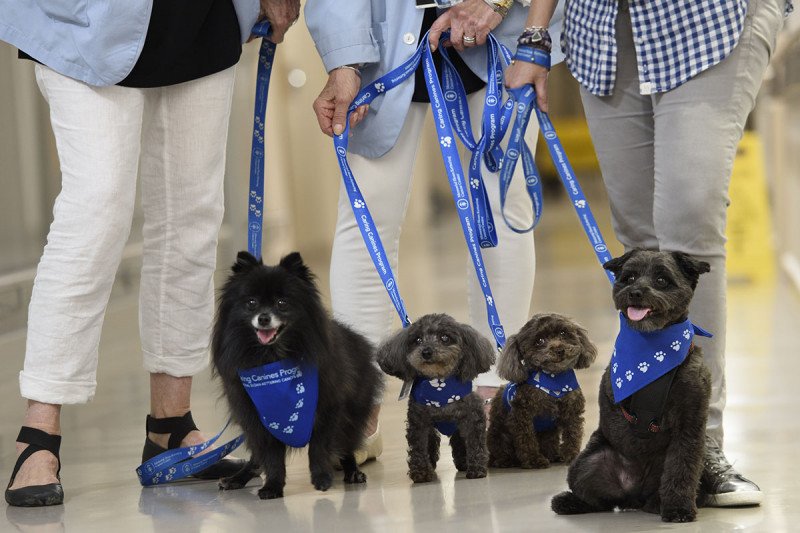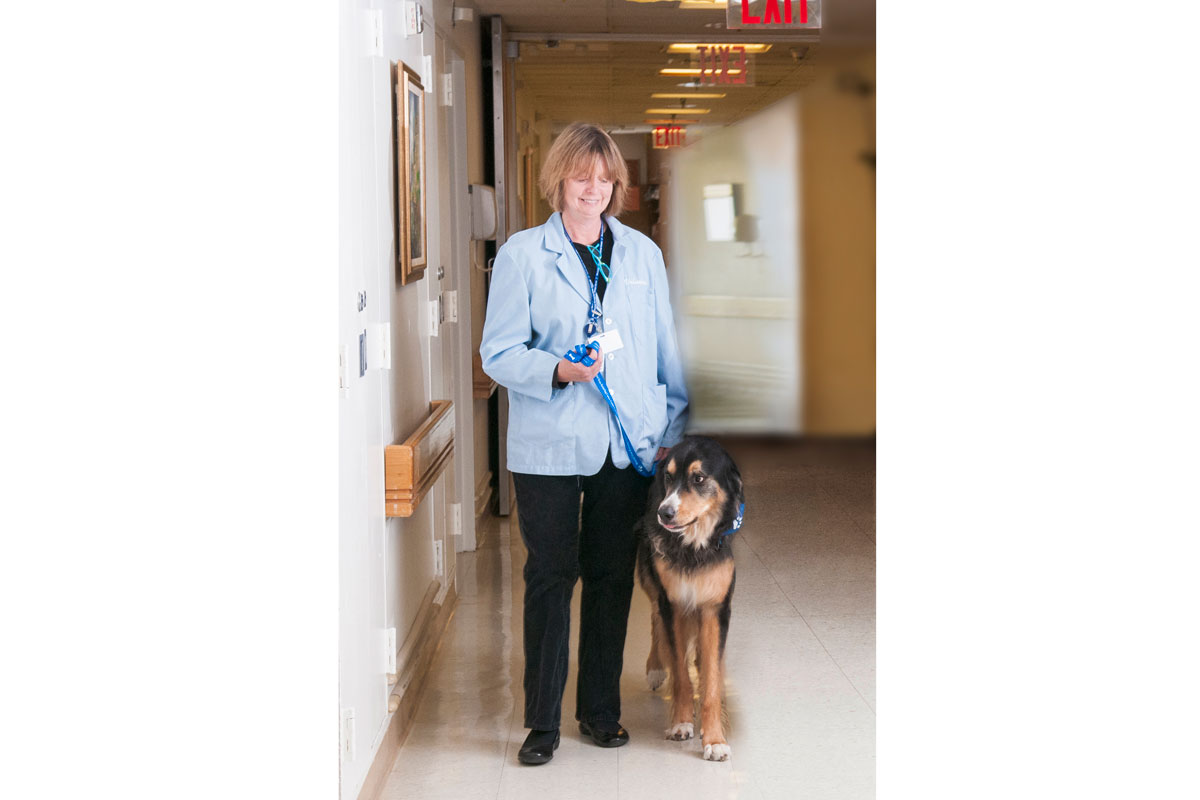
Caring Canines, Satchmo, Blackberry, Twitter, and Finn make the rounds at Memorial Hospital.
Editor’s note: During the COVID-19 pandemic, Memorial Sloan Kettering’s Caring Canines therapy dog program is largely on hold. However, we are providing limited opportunities for virtual visits with our playful pups during this time. Current MSK inpatients and outpatients can email volunteerresources@mskcc.org to request a visit.
Wagging tails. Wet noses. Soft, warm bellies. It’s not surprising that getting a visit from a therapy dog while receiving cancer treatment boosts the spirits. But these visitors do more than put smiles on the faces of people with cancer — they may actually help some people heal.
“Getting up and moving around after surgery is important to the recovery process, but it’s hard for many people to do,” says Jane Kopelman, who runs the Caring Canines therapy dog program at Memorial Sloan Kettering. Sometimes all it takes is a nudge from a four-legged friend. “I see patients who are willing to get out of bed, and even take a walk down the hallway, just so they can spend more time with one of the dogs,” she says.
Making the Rounds
Over the past 12 years, MSK’s Caring Canines have become a fixture in almost every area of patient care. The program started on a single floor with seven dogs. Now, about 50 therapy dogs and their handlers, who are all volunteers, make the rounds throughout MSK. Both handlers and pups sport identification badges so that passersby know that they are the real deal.
In addition to visiting inpatients, therapy dogs also make regular visits to MSK’s outpatient locations, including its regional sites. When MSK’s newest facility, the David H. Koch Center for Cancer Care at Memorial Sloan Kettering Cancer Center, opened to patients in January 2020, the Caring Canines were there.

Jane Kopelman and her dog, Wally, visit Memorial Hospital in 2010.
Ms. Kopelman and her mixed-breed dog, Wally, were one of the first volunteer pairs to come to MSK when the Caring Canines program launched in 2007. She quickly realized she wanted to get more involved, and she officially became the Caring Canines consultant in 2014. “It was clear that the program was going to grow a lot, and they needed someone to safely run it,” she says.
Safety is important, especially because many people being treated for cancer have compromised immune systems. Therapy dogs need a host of vaccines and frequent health screenings. They also get bathed and groomed right before visiting MSK. To make sure they don’t tire out, there are limits on how many hours the dogs can work in each shift.
Furry Motivators
In addition to their work as cheer bringers, some of MSK’s Caring Canines have taken part in published research. This got them one step closer to earning their white lab coats — and maybe eventually, their PhD(og)s.
In April 2018, a team led by Pamela Ginex, who was then a nurse researcher at MSK, published a study in the Clinical Journal of Oncology Nursing (CJON) that looked at the benefits of therapy dogs for people recovering from surgery on the 15th floor of Memorial Hospital. At the time, Caring Canines were not yet visiting this floor. People who’d had surgery, as well as their family members and the nursing staff, completed questionnaires on their levels of stress and sense of well-being before and after the visits. This was the first-ever published study to also look at whether therapy dogs can improve job satisfaction for hospital staff in an inpatient setting.
“We had many patients who were having a hard time getting out of bed after having abdominal surgery,” says MSK nurse practitioner Mary Montefusco, who was a co-author on the CJON study. “But when they heard the dogs were on the way, they wanted to get up and sit in a chair so it would be easier to pet them.”
The improvement seen in people who received visits from the dogs was not statistically significant when compared with those who didn’t get visits. (Studies done at other hospitals have shown stronger gains.) The MSK researchers believe this was the case because people progressively feel better as they recover from surgery — whether they get visits from therapy dogs or not.
Anecdotally, however, the sessions were a huge success, not only for the people with cancer but also for their family members and even for staff. “It always brightens my day when I see one of the dogs,” Ms. Montefusco says.
Since the research was published, the Caring Canines have continued visiting the 15th floor and have expanded into more inpatient areas of the hospital. Most recently they’ve started working on the 18th floor, where people recover from surgery for lung cancer. People who are receiving blood and marrow stem cell transplants can now have pooch meet-and-greets, if their immune systems are strong enough. The dogs have started visiting MSK Kids patients as well, meeting up in a play area rather than patients’ rooms to avoid disruptions.
It’s a “Ruff” Job
It takes a rare breed to make it through the rigorous training process that qualifies a dog to work in a medical setting. Not literally, though. Ms. Kopelman says that any dog is capable of becoming a therapy dog, from the tiniest Chihuahua to some really big woofers. The traits required are more about an individual dog’s personality and temperament. “You need a dog that can roll with anything,” she says. “You don’t want them to get flustered and start barking.”
Their handlers also need to complete rigorous training. They are sometimes brought into situations that are emotionally difficult, such as visiting people who are receiving intensive care or those who are at the end of life. “The dog handlers are a vital part of the team,” Ms. Kopelman says.
“Currently, the demand for therapy dogs is much higher than the supply,” Ms. Kopelman concludes. “We would love to have more dogs and volunteers. The most common thing we hear from patients when we arrive at their bedside with a dog is ‘I’ve been waiting all day for this visit.’ ”


